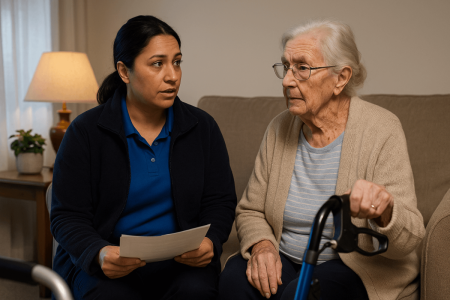Calls grow louder for the government to stop stalling on home care
- Replies 0
When 93-year-old Robyn Rawson was told she’d have to wait up to nine months for a high-level home care package, her response was painfully matter-of-fact: “Well, that’s not much use to me… I’m going to be dead by then.”
Sadly, she was right – within months, Robyn’s health deteriorated and she passed away, never receiving the extra help she’d been approved for.
Her story is not an isolated tragedy. Across Australia, tens of thousands of older people are stuck waiting for promised support to live at home, caught in a backlog that’s only growing.
Now, a chorus of voices – from advocacy groups to aged care providers and even federal crossbench MPs – is urging the government to end the delays and release more home care packages immediately.
“The Home Care Packages program was initially launched with less than 100,000 packages. We’re now up over 300,000 packages and the program is struggling to keep pace,” a Department of Health official told a Senate committee, noting the level of demand is “unprecedented”.
Many older Australians rely on home care services to stay independent. Delays in accessing packages mean some seniors go without crucial help at home.
Wait times have blown out as a result. Government data from early 2025 revealed over 81,000 seniors were queued for care as of 31 January. On average, an older person approved for a package now waits around six to seven months for services – up from about five months late last year. For those needing higher levels of care, the wait can be even longer. In fact, some people assessed for a Level 4 package (the highest level) with medium priority are waiting roughly 12–13 months to get the support they need.
“The current wait times are simply unacceptable,” says Craig Gear, head of the Older Persons Advocacy Network (OPAN). “There is a need for a continual flow of Home Care Packages so older people don’t functionally decline while waiting for the care and support they need. Lack of appropriate care and support also pushes older people into residential aged care against their choice.”
It’s a cruel Catch-22: the longer seniors wait for help at home, the more their health can decline, potentially landing them in the very nursing homes they hoped to avoid.
“We know the longer people go without appropriate home care support, the higher their risk of injury, hospitalisation and earlier entry into residential aged care,” warns Russell Bricknell, CEO of aged care provider Juniper. And with hospitals and aged care facilities already at capacity, these delays create ripple effects across the health system.
This reform was supposed to kick off on 1 July 2025 and come with a major boost: 83,000 extra home care packages, enough (in theory) to clear the backlog and then some. But in early June, the government announced a four-month delay to the start of the new Aged Care Act and the Support at Home program, moving the launch from July to 1 November 2025.
Officials said aged care providers and workers needed more time to prepare for the ambitious changes. Indeed, many in the sector welcomed taking a few extra months to get the complex reforms right. However, that delay came with an unintended side effect: it also pushed back the rollout of those 83,000 new home care packages, leaving people on the waitlist in limbo for longer.
“I think the whole sector was a little shocked to learn the delay to the Act also means the rollout of 83,000 new Home Care Packages will be delayed to 1 November 2025,” Juniper’s Russell Bricknell said. “That means more than 83,000 older Australians are stuck without the help they need which, quite frankly, is not acceptable.”
In the wake of the reform postponement, pressure is mounting on the government to act now rather than make seniors wait until November for relief. Ten federal crossbenchers – a group of independent and minor party MPs often called the “teals” and others – have banded together and written to the government, urging the immediate release of 20,000 home care packages from 1 July. It’s their first big collective push on aged care this term, and it’s being echoed loudly by aged care advocates and providers across Australia.
“We’d really like to see those packages released in line with the original timeline,” says Chris Mamarelis, CEO of not-for-profit provider Whiddon, referring to the now-scrapped 1 July start date. “You just have to look at the queue of people waiting to access home care… I think the government has the ability to start releasing some of those packages in advance of the November extension. And I think the community and older Australians need those packages now.”
“As an interim measure, OPAN is calling for 20,000 packages to be released under the existing Home Care Packages Program,” OPAN’s Craig Gear told Australian Ageing Agenda, adding that he is seeking clarification on why releasing packages sooner is tied to the new Act’s timetable.
Gear’s concern is that many elderly people could deteriorate while waiting until November: “The current wait times are simply unacceptable… older people don’t functionally decline while waiting for the care and support they need.” He notes that while some basic help is available through the Commonwealth Home Support Program in the meantime, it “falls well short of the level of care they need in terms of quality, consistency and accessibility.”
Independent MP Helen Haines – one of the crossbenchers who signed the letter – agrees the situation is urgent. “We know that if we wait until November, more and more people come onto the waitlist,” she says. “And the longer that they wait, the higher the chances of further deterioration in their health and in many cases a premature entry into residential aged care.”
Haines and her crossbench colleagues are essentially pleading: don’t let the perfect reform be the enemy of the good. Even if the new Support at Home system isn’t ready yet, they argue, the government could start funding additional packages now under the existing scheme to give relief to thousands of families.
Providers, too, are adding their voices. “It’s good to see pressure mounting on the government to release at least 20,000 packages by the original 1 July deadline,” says Juniper’s Russell Bricknell, who has been vocal on the issue. “We know both hospitals and residential aged care facilities are at capacity… It’s a practical, necessary step that will ease current pressure on individuals and families and ensure older people can live safely and independently in their homes as they wait for the new Support at Home system to come into place.”
Bricknell has even called for a one-off funding commitment to fully clear the Home Care Package waitlist – essentially a catch-up injection so that the backlog of tens of thousands of approved seniors is wiped out. That idea might carry a hefty price tag, but advocates argue it’s a “necessary step” to uphold older Australians’ quality of life.
Tom Symondson, CEO of the peak body Aging Australia (representing non-profit aged care providers), has been blunt about the stakes. “The waiting list is already more than 80,000 people on it, and that was back in February,” he told the ABC. “We need to see packages start to flow. If we don’t see them flow until November, we’re just going to see potentially well over 100,000 people waiting.”
In other words, delaying action will let the queue grow by another 20,000 people or more – wiping out any benefit of releasing 20,000 packages later in the year. Symondson points out that a Level 4 package can provide nearly $80,000 worth of care per year, which is “absolutely life-changing for an older person who wants to stay at home.” Every month of delay is a month someone goes without that life-changing support.
Peak bodies like the Aged & Community Care Providers Association (ACCPA) had called for 80,000 new packages to meet demand, and major providers such as Bolton Clarke (one of the country’s largest home care providers) recommended adding at least 40,000 more packages on top of that.
By contrast, the government’s 24,100 was a fraction of what experts said was needed, and even opposition politicians blasted it as woefully inadequate – a design that would “intentionally” lengthen wait times to an average of six months, according to Shadow Aged Care Minister Anne Ruston.
Faced with criticism and the clear gap between supply and demand, the Government did boost the numbers slightly mid-year. In the December 2024 Mid-Year Economic update, it announced an extra 7,615 packages would be released, on top of the original 24,100. By the start of 2025, roughly 20,300 of those new packages had been released to people on the waitlist.
But even with around 31,700 packages rolling out in the financial year, the queue continued to grow – illustrating just how many new seniors are requesting care each month. “The level of demand for home care is unprecedented,” a Department of Health official explained, noting that assessors now commonly mark people as “high priority” (which guarantees faster access) because the needs are so urgent.
That triaging, while necessary, has a knock-on effect: when more people get bumped up to high priority (who must be served within 30 days), everyone else in the “medium priority” category waits even longer.
Looking ahead, the Albanese Government has promised a big surge in supply from mid-2025 – those 83,000 additional packages to be delivered in 2025–26, followed by another 24,000 in 2026–27. These targets are tied to the new Support at Home program and are meant to finally bring wait times down to more acceptable levels. In fact, the Minister for Aged Care had set an official goal to reduce the maximum wait to three months by July 2027.
It’s an ambitious aim, and one broadly in line with what the Royal Commission into Aged Care Quality and Safety recommended – that older Australians shouldn’t be left languishing, and that aged care should ultimately move to a “demand-driven” system where if you’re assessed as needing support, you get it, without an arbitrary cap on package numbers.
However, experts are skeptical that the current plans will be enough to reach that three-month wait target. “With a current wait list in the 80,000s, it seems unlikely these numbers will be enough [to reach the target],” says Ian Yates AM, former Chief Executive of COTA Australia and until recently the Aged Care Inspector-General.
Yates has been outspoken about what he calls the “disgrace” of letting tens of thousands of people who’ve already been approved for care go without it. “Government agrees these people need support and care, but denies them receiving it,” he wrote in a commentary on the issue. “People will die badly.”
Yates lamented that despite the Royal Commission’s calls to eliminate waitlists, the new system will still ration care via limited packages – a choice he argues is “contrary to the rights set out in the new Act, and basic values.”
His fears are not abstract. We’ve already seen what happens when the system falls behind: just a couple of years ago, Australia managed to slash home care waiting times to record lows, only to see them blow out again. By the end of February 2023 – after a concerted effort and thousands of extra packages funded by the previous government – wait times had briefly dropped to around 1–3 months for all package levels. It proved that with enough resources, the backlog could be tamed. But since then, as investment slowed and demand kept rising, waits have rapidly expanded again.
“Everyone agreed it shouldn’t happen but here we are again, having the same conversation,” one seniors’ advocate noted wryly. For older Australians, it’s déjà vu – and not in a good way.
These stories are fueling public outrage and anxiety among Australia’s seniors. Rebekha Sharkie, an independent MP, called the situation “shameful” when revelations about intentional wait time increases surfaced last year. Seniors advocacy organisations like National Seniors Australia point out that the official wait time figures often understate reality, because they don’t count the weeks or months it takes just to get assessed and approved in the first place.
By the time an older person gets their “approval” letter and joins that 80,000-strong queue, they may already have been navigating the system for weeks. It all adds up.
“As the Royal Commission heard all those years ago, people were receiving approvals for care long after they were assessed – in some instances, they died waiting,” National Seniors Chief Advocate Ian Henschke reminds us. “Everyone agreed it shouldn’t happen, but here we are again.”
The federal government, for its part, has been relatively quiet in the face of the latest criticism. When asked by media, ministers tend to emphasize the importance of the broader reform and the need to ensure a smooth rollout in November. They highlight that the aged care budget is at record levels and that thousands of packages are being released, just not all at once.
But notably, the government hasn’t directly explained why some of the 83,000 forthcoming packages couldn’t be brought forward now under the old program. Advocates like OPAN’s Craig Gear are perplexed by this, pressing for clarification on why interim packages can’t be offered.
To an everyday Aussie senior, it likely feels like bureaucracy standing in the way of common sense – “we know you need help, but sorry, you’ll have to wait until our new system is ready to go.”
Will the government listen and find a way to speed up the flow of home care packages before November? Or will it stick to the current plan, hold everything back for the new program launch, and hope that interim measures like basic home support services can tide people over?
There are a few reasons to be cautiously optimistic. The very public pressure from crossbench MPs, peak bodies, and advocacy groups seems to be striking a chord. It’s politically risky to ignore a group of tenacious independents championing the cause of vulnerable seniors – especially when they can point to stories like Robyn’s. And as Australia’s population ages, the importance of aged care only grows; no government wants to be seen as failing retirees. We’ve also seen the government adjust course before: the addition of 7,615 extra packages mid-year came after sustained lobbying.
It’s possible we could see another top-up announced to appease critics and ease the backlog before November, even if not the full 20,000 asked for.
Yet, it’s also possible that bureaucratic inertia and budget constraints will prevail, meaning little changes until the big reform finally arrives. Releasing tens of thousands of packages early would cost money – potentially hundreds of millions of dollars – at a time when every government dollar is contested.
Officials might also be reluctant to tinker with the old system when a new one is imminent, fearing operational hiccups. Essentially, they might calculate that it’s “only” a few more months of pain, and that the new Support at Home program (with its promised surge of packages and systemic fixes) will solve the problem soon enough.
From the perspective of an older Australian waiting for help, that kind of calculation is hard to swallow. As one industry veteran put it, if someone’s been assessed as needing care, how can we morally justify making them wait at all? “If the need is that, then that’s the need,” says Yvonne Timson, CEO of Community Vision, rejecting the idea that bureaucratic triage should limit care. In her view, blaming long waits on assessors labeling more people high-priority misses the point – the real issue is that all these people genuinely need support, and we haven’t funded enough of it.
So, where does this leave us? Older Australians and their families are watching closely. They’ve heard many promises that aged care will improve – from the Royal Commission’s scathing report, to election pledges to “fix aged care,” to this grand new Support at Home scheme in the wings.
And yet, here we are, still with thousands of elders waiting, worrying, and in too many cases suffering unnecessarily due to delays.
As we await the government’s next move, one can’t help but wonder: What kind of aged care future do we want for Australia? Will we choose to ensure that every senior gets the help they need when they need it – even if it means spending more, sooner – or will we continue with a system where care comes only after a long and dangerous wait? It’s a question worth pondering.
None of us would want to wait months or years for the care we’ve been promised. So, what do you think: will Australia find the will (and the wallet) to finally end the wait for home care, or are we content to leave our seniors in limbo?
Sadly, she was right – within months, Robyn’s health deteriorated and she passed away, never receiving the extra help she’d been approved for.
Her story is not an isolated tragedy. Across Australia, tens of thousands of older people are stuck waiting for promised support to live at home, caught in a backlog that’s only growing.
Now, a chorus of voices – from advocacy groups to aged care providers and even federal crossbench MPs – is urging the government to end the delays and release more home care packages immediately.
A Growing Backlog of Older Australians in Need
Right now, about 80,000 older Australians are on the national waitlist for a Home Care Package – and that number is climbing. Home Care Packages provide different levels of funding for services like cleaning, bathing, meal preparation, nursing, and transport, enabling seniors to stay independent in their own homes. Demand for these packages has exploded in recent years as more people choose to age in place.“The Home Care Packages program was initially launched with less than 100,000 packages. We’re now up over 300,000 packages and the program is struggling to keep pace,” a Department of Health official told a Senate committee, noting the level of demand is “unprecedented”.
Many older Australians rely on home care services to stay independent. Delays in accessing packages mean some seniors go without crucial help at home.
Wait times have blown out as a result. Government data from early 2025 revealed over 81,000 seniors were queued for care as of 31 January. On average, an older person approved for a package now waits around six to seven months for services – up from about five months late last year. For those needing higher levels of care, the wait can be even longer. In fact, some people assessed for a Level 4 package (the highest level) with medium priority are waiting roughly 12–13 months to get the support they need.
“The current wait times are simply unacceptable,” says Craig Gear, head of the Older Persons Advocacy Network (OPAN). “There is a need for a continual flow of Home Care Packages so older people don’t functionally decline while waiting for the care and support they need. Lack of appropriate care and support also pushes older people into residential aged care against their choice.”
It’s a cruel Catch-22: the longer seniors wait for help at home, the more their health can decline, potentially landing them in the very nursing homes they hoped to avoid.
“We know the longer people go without appropriate home care support, the higher their risk of injury, hospitalisation and earlier entry into residential aged care,” warns Russell Bricknell, CEO of aged care provider Juniper. And with hospitals and aged care facilities already at capacity, these delays create ripple effects across the health system.
Promised Reform, Delayed at the Last Minute
Why are so many older Australians waiting, when everyone agrees they need care? A big part of the story is that the federal government has been preparing a new Support at Home program – a once-in-a-generation reform meant to replace the current Home Care Package scheme.This reform was supposed to kick off on 1 July 2025 and come with a major boost: 83,000 extra home care packages, enough (in theory) to clear the backlog and then some. But in early June, the government announced a four-month delay to the start of the new Aged Care Act and the Support at Home program, moving the launch from July to 1 November 2025.
Officials said aged care providers and workers needed more time to prepare for the ambitious changes. Indeed, many in the sector welcomed taking a few extra months to get the complex reforms right. However, that delay came with an unintended side effect: it also pushed back the rollout of those 83,000 new home care packages, leaving people on the waitlist in limbo for longer.
“I think the whole sector was a little shocked to learn the delay to the Act also means the rollout of 83,000 new Home Care Packages will be delayed to 1 November 2025,” Juniper’s Russell Bricknell said. “That means more than 83,000 older Australians are stuck without the help they need which, quite frankly, is not acceptable.”
In the wake of the reform postponement, pressure is mounting on the government to act now rather than make seniors wait until November for relief. Ten federal crossbenchers – a group of independent and minor party MPs often called the “teals” and others – have banded together and written to the government, urging the immediate release of 20,000 home care packages from 1 July. It’s their first big collective push on aged care this term, and it’s being echoed loudly by aged care advocates and providers across Australia.
“We’d really like to see those packages released in line with the original timeline,” says Chris Mamarelis, CEO of not-for-profit provider Whiddon, referring to the now-scrapped 1 July start date. “You just have to look at the queue of people waiting to access home care… I think the government has the ability to start releasing some of those packages in advance of the November extension. And I think the community and older Australians need those packages now.”
“We Can’t Afford to Wait”: Sector and Advocates Speak Out
From community advocacy groups to the aged care industry, there’s a unified call for urgent action to get seniors the help they’ve been promised.“As an interim measure, OPAN is calling for 20,000 packages to be released under the existing Home Care Packages Program,” OPAN’s Craig Gear told Australian Ageing Agenda, adding that he is seeking clarification on why releasing packages sooner is tied to the new Act’s timetable.
Gear’s concern is that many elderly people could deteriorate while waiting until November: “The current wait times are simply unacceptable… older people don’t functionally decline while waiting for the care and support they need.” He notes that while some basic help is available through the Commonwealth Home Support Program in the meantime, it “falls well short of the level of care they need in terms of quality, consistency and accessibility.”
Independent MP Helen Haines – one of the crossbenchers who signed the letter – agrees the situation is urgent. “We know that if we wait until November, more and more people come onto the waitlist,” she says. “And the longer that they wait, the higher the chances of further deterioration in their health and in many cases a premature entry into residential aged care.”
Haines and her crossbench colleagues are essentially pleading: don’t let the perfect reform be the enemy of the good. Even if the new Support at Home system isn’t ready yet, they argue, the government could start funding additional packages now under the existing scheme to give relief to thousands of families.
Providers, too, are adding their voices. “It’s good to see pressure mounting on the government to release at least 20,000 packages by the original 1 July deadline,” says Juniper’s Russell Bricknell, who has been vocal on the issue. “We know both hospitals and residential aged care facilities are at capacity… It’s a practical, necessary step that will ease current pressure on individuals and families and ensure older people can live safely and independently in their homes as they wait for the new Support at Home system to come into place.”
Bricknell has even called for a one-off funding commitment to fully clear the Home Care Package waitlist – essentially a catch-up injection so that the backlog of tens of thousands of approved seniors is wiped out. That idea might carry a hefty price tag, but advocates argue it’s a “necessary step” to uphold older Australians’ quality of life.
Tom Symondson, CEO of the peak body Aging Australia (representing non-profit aged care providers), has been blunt about the stakes. “The waiting list is already more than 80,000 people on it, and that was back in February,” he told the ABC. “We need to see packages start to flow. If we don’t see them flow until November, we’re just going to see potentially well over 100,000 people waiting.”
In other words, delaying action will let the queue grow by another 20,000 people or more – wiping out any benefit of releasing 20,000 packages later in the year. Symondson points out that a Level 4 package can provide nearly $80,000 worth of care per year, which is “absolutely life-changing for an older person who wants to stay at home.” Every month of delay is a month someone goes without that life-changing support.
Budget Promises vs Reality
Behind this debate lies a numbers game that has been evolving over successive federal budgets. In the May 2024 budget, the Albanese Government allocated funding for 24,100 new home care packages in 2024–25. At the time, there were around 76,000 people on the waiting list – meaning only about one in three of those waiting would get a package within the year. The aged care sector loudly warned this wasn’t enough.Peak bodies like the Aged & Community Care Providers Association (ACCPA) had called for 80,000 new packages to meet demand, and major providers such as Bolton Clarke (one of the country’s largest home care providers) recommended adding at least 40,000 more packages on top of that.
By contrast, the government’s 24,100 was a fraction of what experts said was needed, and even opposition politicians blasted it as woefully inadequate – a design that would “intentionally” lengthen wait times to an average of six months, according to Shadow Aged Care Minister Anne Ruston.
Faced with criticism and the clear gap between supply and demand, the Government did boost the numbers slightly mid-year. In the December 2024 Mid-Year Economic update, it announced an extra 7,615 packages would be released, on top of the original 24,100. By the start of 2025, roughly 20,300 of those new packages had been released to people on the waitlist.
But even with around 31,700 packages rolling out in the financial year, the queue continued to grow – illustrating just how many new seniors are requesting care each month. “The level of demand for home care is unprecedented,” a Department of Health official explained, noting that assessors now commonly mark people as “high priority” (which guarantees faster access) because the needs are so urgent.
That triaging, while necessary, has a knock-on effect: when more people get bumped up to high priority (who must be served within 30 days), everyone else in the “medium priority” category waits even longer.
Looking ahead, the Albanese Government has promised a big surge in supply from mid-2025 – those 83,000 additional packages to be delivered in 2025–26, followed by another 24,000 in 2026–27. These targets are tied to the new Support at Home program and are meant to finally bring wait times down to more acceptable levels. In fact, the Minister for Aged Care had set an official goal to reduce the maximum wait to three months by July 2027.
It’s an ambitious aim, and one broadly in line with what the Royal Commission into Aged Care Quality and Safety recommended – that older Australians shouldn’t be left languishing, and that aged care should ultimately move to a “demand-driven” system where if you’re assessed as needing support, you get it, without an arbitrary cap on package numbers.
However, experts are skeptical that the current plans will be enough to reach that three-month wait target. “With a current wait list in the 80,000s, it seems unlikely these numbers will be enough [to reach the target],” says Ian Yates AM, former Chief Executive of COTA Australia and until recently the Aged Care Inspector-General.
Yates has been outspoken about what he calls the “disgrace” of letting tens of thousands of people who’ve already been approved for care go without it. “Government agrees these people need support and care, but denies them receiving it,” he wrote in a commentary on the issue. “People will die badly.”
Yates lamented that despite the Royal Commission’s calls to eliminate waitlists, the new system will still ration care via limited packages – a choice he argues is “contrary to the rights set out in the new Act, and basic values.”
His fears are not abstract. We’ve already seen what happens when the system falls behind: just a couple of years ago, Australia managed to slash home care waiting times to record lows, only to see them blow out again. By the end of February 2023 – after a concerted effort and thousands of extra packages funded by the previous government – wait times had briefly dropped to around 1–3 months for all package levels. It proved that with enough resources, the backlog could be tamed. But since then, as investment slowed and demand kept rising, waits have rapidly expanded again.
“Everyone agreed it shouldn’t happen but here we are again, having the same conversation,” one seniors’ advocate noted wryly. For older Australians, it’s déjà vu – and not in a good way.
The Human Cost of Delayed Care
Behind all these numbers and plans, it’s crucial to remember the human reality of what these delays mean. They mean couples in their 80s struggling on their own for months longer, waiting for a carer to help with showers or meal prep. They mean adult children fretting that their frail mum or dad hasn’t got the support promised. In the worst cases, they mean people like Robyn Rawson quite literally run out of time before help arrives.These stories are fueling public outrage and anxiety among Australia’s seniors. Rebekha Sharkie, an independent MP, called the situation “shameful” when revelations about intentional wait time increases surfaced last year. Seniors advocacy organisations like National Seniors Australia point out that the official wait time figures often understate reality, because they don’t count the weeks or months it takes just to get assessed and approved in the first place.
By the time an older person gets their “approval” letter and joins that 80,000-strong queue, they may already have been navigating the system for weeks. It all adds up.
“As the Royal Commission heard all those years ago, people were receiving approvals for care long after they were assessed – in some instances, they died waiting,” National Seniors Chief Advocate Ian Henschke reminds us. “Everyone agreed it shouldn’t happen, but here we are again.”
The federal government, for its part, has been relatively quiet in the face of the latest criticism. When asked by media, ministers tend to emphasize the importance of the broader reform and the need to ensure a smooth rollout in November. They highlight that the aged care budget is at record levels and that thousands of packages are being released, just not all at once.
But notably, the government hasn’t directly explained why some of the 83,000 forthcoming packages couldn’t be brought forward now under the old program. Advocates like OPAN’s Craig Gear are perplexed by this, pressing for clarification on why interim packages can’t be offered.
To an everyday Aussie senior, it likely feels like bureaucracy standing in the way of common sense – “we know you need help, but sorry, you’ll have to wait until our new system is ready to go.”
Where To From Here?
With the new Support at Home start date (November 1, 2025) still months away, the big question is what happens in the meantime. The aged care sector is essentially saying: too many older Australians are in limbo right now – we can’t just hit pause.Will the government listen and find a way to speed up the flow of home care packages before November? Or will it stick to the current plan, hold everything back for the new program launch, and hope that interim measures like basic home support services can tide people over?
There are a few reasons to be cautiously optimistic. The very public pressure from crossbench MPs, peak bodies, and advocacy groups seems to be striking a chord. It’s politically risky to ignore a group of tenacious independents championing the cause of vulnerable seniors – especially when they can point to stories like Robyn’s. And as Australia’s population ages, the importance of aged care only grows; no government wants to be seen as failing retirees. We’ve also seen the government adjust course before: the addition of 7,615 extra packages mid-year came after sustained lobbying.
It’s possible we could see another top-up announced to appease critics and ease the backlog before November, even if not the full 20,000 asked for.
Yet, it’s also possible that bureaucratic inertia and budget constraints will prevail, meaning little changes until the big reform finally arrives. Releasing tens of thousands of packages early would cost money – potentially hundreds of millions of dollars – at a time when every government dollar is contested.
Officials might also be reluctant to tinker with the old system when a new one is imminent, fearing operational hiccups. Essentially, they might calculate that it’s “only” a few more months of pain, and that the new Support at Home program (with its promised surge of packages and systemic fixes) will solve the problem soon enough.
From the perspective of an older Australian waiting for help, that kind of calculation is hard to swallow. As one industry veteran put it, if someone’s been assessed as needing care, how can we morally justify making them wait at all? “If the need is that, then that’s the need,” says Yvonne Timson, CEO of Community Vision, rejecting the idea that bureaucratic triage should limit care. In her view, blaming long waits on assessors labeling more people high-priority misses the point – the real issue is that all these people genuinely need support, and we haven’t funded enough of it.
So, where does this leave us? Older Australians and their families are watching closely. They’ve heard many promises that aged care will improve – from the Royal Commission’s scathing report, to election pledges to “fix aged care,” to this grand new Support at Home scheme in the wings.
And yet, here we are, still with thousands of elders waiting, worrying, and in too many cases suffering unnecessarily due to delays.
As we await the government’s next move, one can’t help but wonder: What kind of aged care future do we want for Australia? Will we choose to ensure that every senior gets the help they need when they need it – even if it means spending more, sooner – or will we continue with a system where care comes only after a long and dangerous wait? It’s a question worth pondering.
None of us would want to wait months or years for the care we’ve been promised. So, what do you think: will Australia find the will (and the wallet) to finally end the wait for home care, or are we content to leave our seniors in limbo?










